Telehandlers on test: Kramer KT407
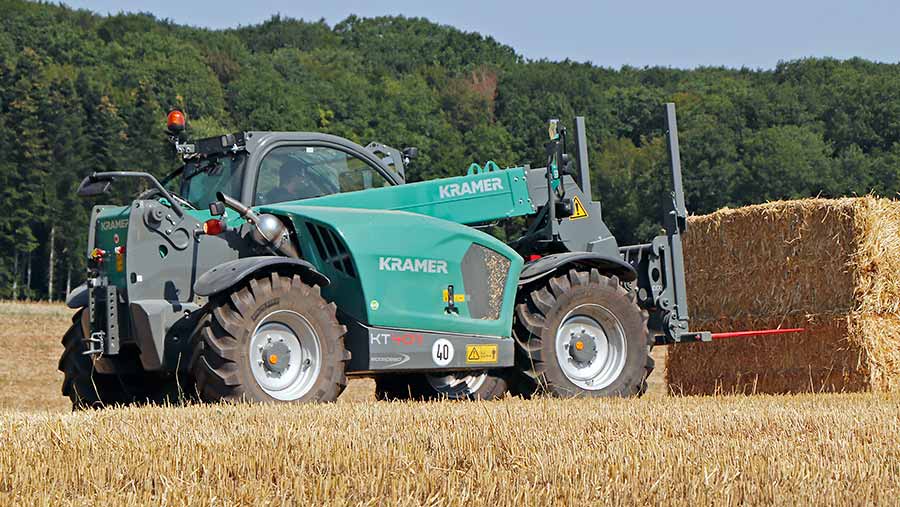
In an extension of our telehandler test in the 4t lift and 7m reach category, we have taken a look at the best-selling rigid-frame machines from Kramer, Claas, Cat and Bobcat.
Kramer has been hard at work relaunching the old Claas Scorpion models in its own livery. With no agricultural dealerships on its books, the firm has managed to strike a deal to sell through John Deere’s network, which has led to some impressive early sales success
Meanwhile, following its split from manufacturing partner Kramer, Claas has put the finishing touches to its new range of Scorpion handlers, this time built by Liebherr.
See also: Telehandler test: 5 mid-sized loaders battle it out
Although not a key player in the agricultural market yet, Caterpillar is also looking to grow its presence with the recently released D-series handler. Massey Ferguson is in the game too, and continues to offer its flagship TH.7038, based on the same platform as the Bobcat we tested last year.
The test was carried out on a dairy farm near Besancon, close to the French/Swiss border, with our colleagues from French magazine La France Agricole and the German publication Top Agrar.
The two-week trial included typical on-farm tasks such as bale handling, trailer loading and muckheap work. But to accurately compare their hydraulic performance and lifting prowess, the Germans also hooked them to their comprehensive range of testing equipment.
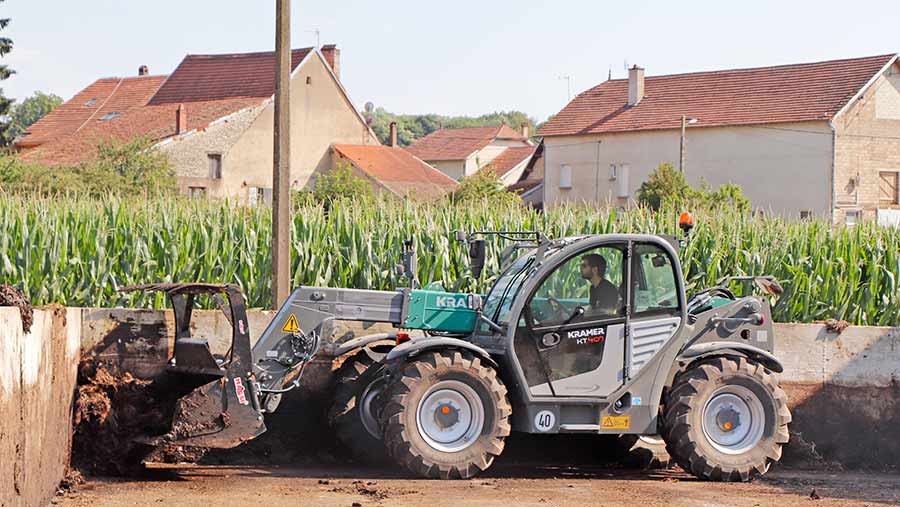
Kramer KT407
The verdict
It might be a relatively new name in the UK, but Kramer’s KT machines have clocked up many years’ service under the guise of Claas livery.
The latest incarnation is basically an uprated version of the KT357 that carries a larger counterweight to increase its maximum lift to 4t.
It’s pretty simple to drive and a solid all-rounder, delivering consistently fast hydraulic performance and a decent lift capacity given its modest overall weight.
Down sides include a cluttered engine bay that makes basic servicing a pain and the lack of a left-hand shuttle that will be unpopular among many operators.
However, we reckon it’s a sound choice at a reasonable price and worthy of taking the top spot in this year’s test. If you can do without the extra 500kg lift capacity then the near-identical KT357 saves you £4,500.
List price: £86,297
The scores
- Build quality: 4
- Cab/ergonomics: 3.5
- Joystick and controls: 3.5
- Engine: 4
- Transmission: 4
- Hydraulics: 4
- Handling: 4.5
- Driving comfort: 3.5
- Total: 31
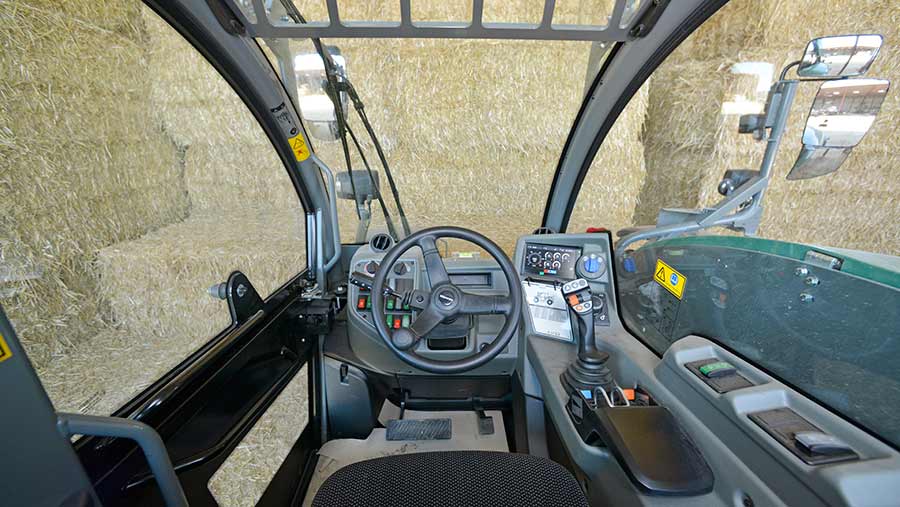
Likes
- Tight turning circle
- Low overall height
- Good all-round hydraulic performance
- Air flow minimises dust below chassis
- Easy-to-fathom controls
- Cushioned boom retract
Gripes
- Small feeling cab with lack of headroom
- Armrest and joystick not attached to the seat
- No left-hand shuttle
- Poor engine bay access
- Bucket position memory not accurate
- Unremarkable right-sided view
Cab
Kramer’s curvy cab frame sits uncomfortably close to the driver’s head, so it feels more claustrophobic than the likes of the Massey Ferguson.
However, the swooping style of the windscreen delivers decent views from shed floor to roof and the cage on the inside of the top section makes the glass easy to wipe clean.
Legroom is more abundant than in the Claas too, and the cab deck was the lowest among our test group (80cm, versus 90.5cm in the Scorpion), which makes access easy and keeps the overall machine height down.
Visibility forwards is helped by the slimline dash, though the bonnet is big and the rear-quarter mudguard remains just about in sight to act as a reference point for avoiding barn stanchions and walls while reversing.
Other noteworthy details include a decent-sized storage bin behind the seat and well-positioned front lights.
Controls
There is nothing radical in the controls department, which makes the Kramer a pretty easy drive.
However, plenty of potential buyers will bemoan the absence of a left-hand shuttle. In its place is a stalk to control indicators, windscreen wipers and lights, while directional changes are dealt with by an orange-coloured roller on the joystick.
We found this was too easily confused with the boom in/out and felt having to control everything with a single thumb made operating several functions at the same time cumbersome and awkward. Fitting a neutral button below the roller doesn’t work that well, either.
The joystick itself is a carbon copy of both the Cat and Claas, though each is set up to work slightly differently. It has a pleasant enough feel, but delicate movements could be made easier by attaching both the armrest and joystick to the air-cushioned seat.
Other controls are grouped on a bank to the left of the steering wheel and are labelled pretty well, while the main screen works as a digital dash display (there are no regular analogue dials) and is very clear.
Like the Cat, it promises a lot at first glance, but it’s fairly limited in what it can do and is mainly for changing recording units, showing hours worked and fuel consumption. The leader in this department is undoubtedly Manitou, which featured in last year’s test.
Vital stats
- Engine 3.6-litre Deutz four-cylinder
- Rated power 136hp
- Transmission Three-speed hydrostatic
- *Hydraulics 140 litres/min
- *Max lift capacity 4t
- *Max lift height 7m
- *Max forward reach 3.76m
- Weight 7.38t
- Turning circle 7.77m
- Complete cycle time 29.3secs
- List price £86,297
*Manufacturer’s stats
Engine
Kramer opts for a 3.6-litre Deutz engine – something it shares with Manitou, Merlo and Claas – which it mounts sideways in an exceptionally cramped engine bay that also contains a little air compressor for the brakes.
Access to some of the regular service items is poor, particularly the engine oil filler cap that is hidden under the clutter of emissions-related components.
On the plus side, it doesn’t blow any air down below the engine bay – it gets drawn through and straight out the back – so bellowing dust clouds are kept to a minimum.
However, the diesel filler is by the rear window, which means you’ll have to shut the top section of the door to get at it.
Transmission
The hydrostatic setup caries three ranges controlled through buttons on the joystick. Naturally, this provides a much smoother drive than the Cat’s powershift.
As with most of the other machines, Kramer fits a speed limiter (controlled by a blue toggle) and an engine rev limiter, which makes it a doddle to set a steady forward speed or maintain constant revs.
Its fairly modest proportions – and the fact that it shares a chassis with the smaller KT357 – contributed to it delivering the best turning circle on test. It was also the narrowest and, as mentioned earlier, the lowest, so is well suited to those working around old-fashioned yards.
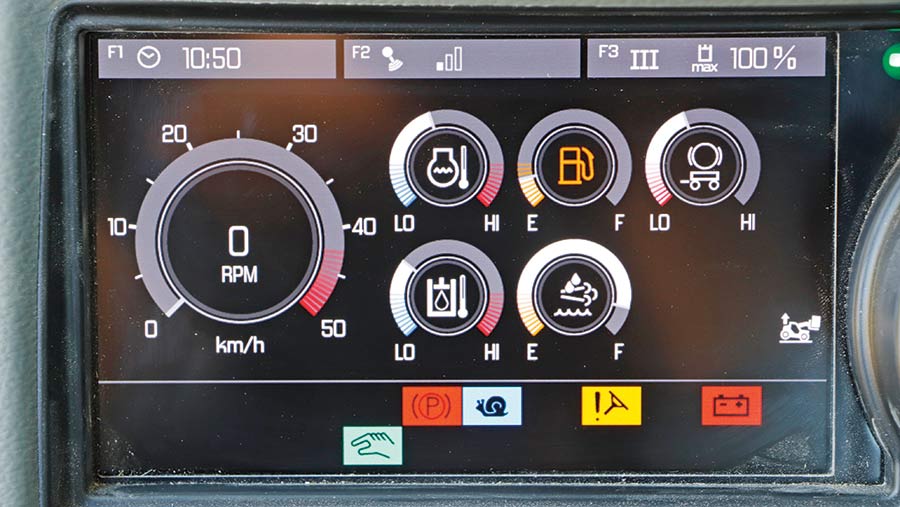
Boom and hydraulics
Kramer delivers the most consistent hydraulic performance. Its 140-litres/min pump might be smaller than some of its rivals, but cycle times at full revs are nothing to be sniffed at – particularly compared with the achingly slow results posted last year by Manitou’s MLT 741.
Lift capacities, too, are pretty good when you take into account the Kramer’s size and top-drawer manoeuvrability.
Like a lot of its rivals, the KT is fitted with different working modes that speed up basic lifting and loading jobs. These include pallet mode (where the headstock goes up in a straight line) and bucket mode, which sees the boom retracted as the headstock is lowered. Both are useful, if you remember to use them.
However, we found the bucket position memory less handy, mainly due to its position drifting after only a few loads.
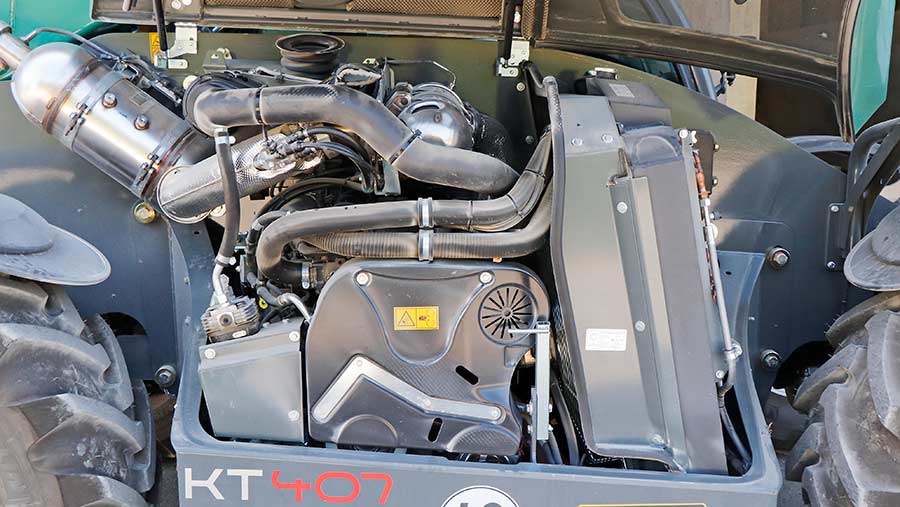
The range
Kramer has been pretty aggressive in expanding its presence in the UK since splitting from Claas.
It hopes to build on the success of the Scorpion (the machine is very similar to pre-2018 models) and has cosied up with several prominent John Deere dealers, including the likes of Doubleday, Tallis Amos, Ripon Farm Services and R Hunts.
Construction specialist Wacker Neuson owns both Kramer and Weidemann and, although it’s a massive company, we wouldn’t be surprised if the machines eventually turn up in Deere’s green and yellow colours.
The ag-spec range includes 10 models that all run Deutz engines and have the same three-speed hydrostatic transmission.
However, there are another eight small machines that run a mix of Yanmar, Kohler, Deutz and Perkins motors from 31hp (on the 800kg/4m KT804) to 100hp (for the 2.3t/4.5m KL35.8T).
Full-size models start with the 136hp KT306 (6.15m reach, 3t lift and 100-litres/min hydraulics) and top of the tree is the KT559 with an 8.75m reach, 5.5t lift and 187-litres/min hydraulics. It is powered by a 156hp Deutz engine and has a list price of £101,837.

